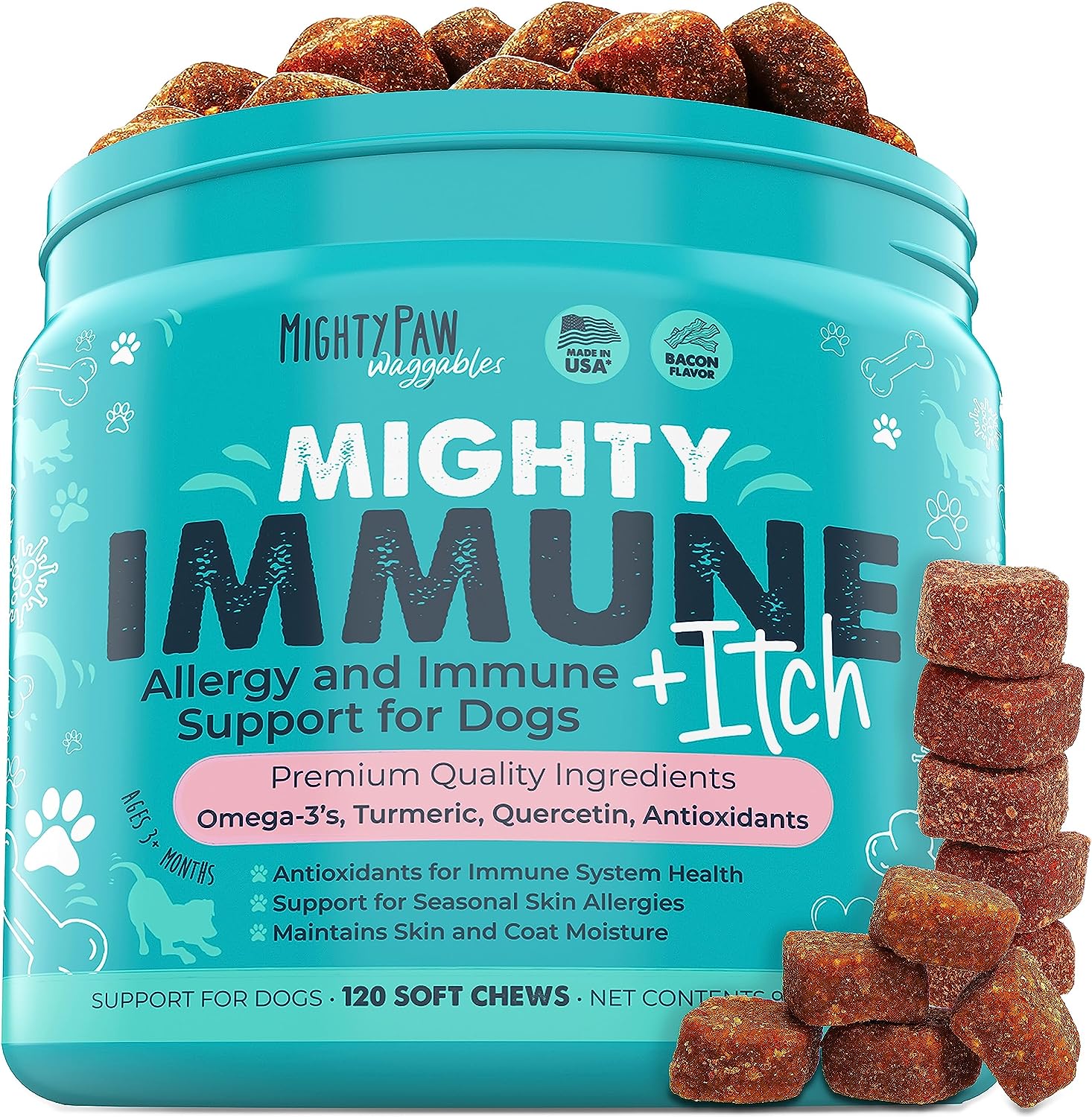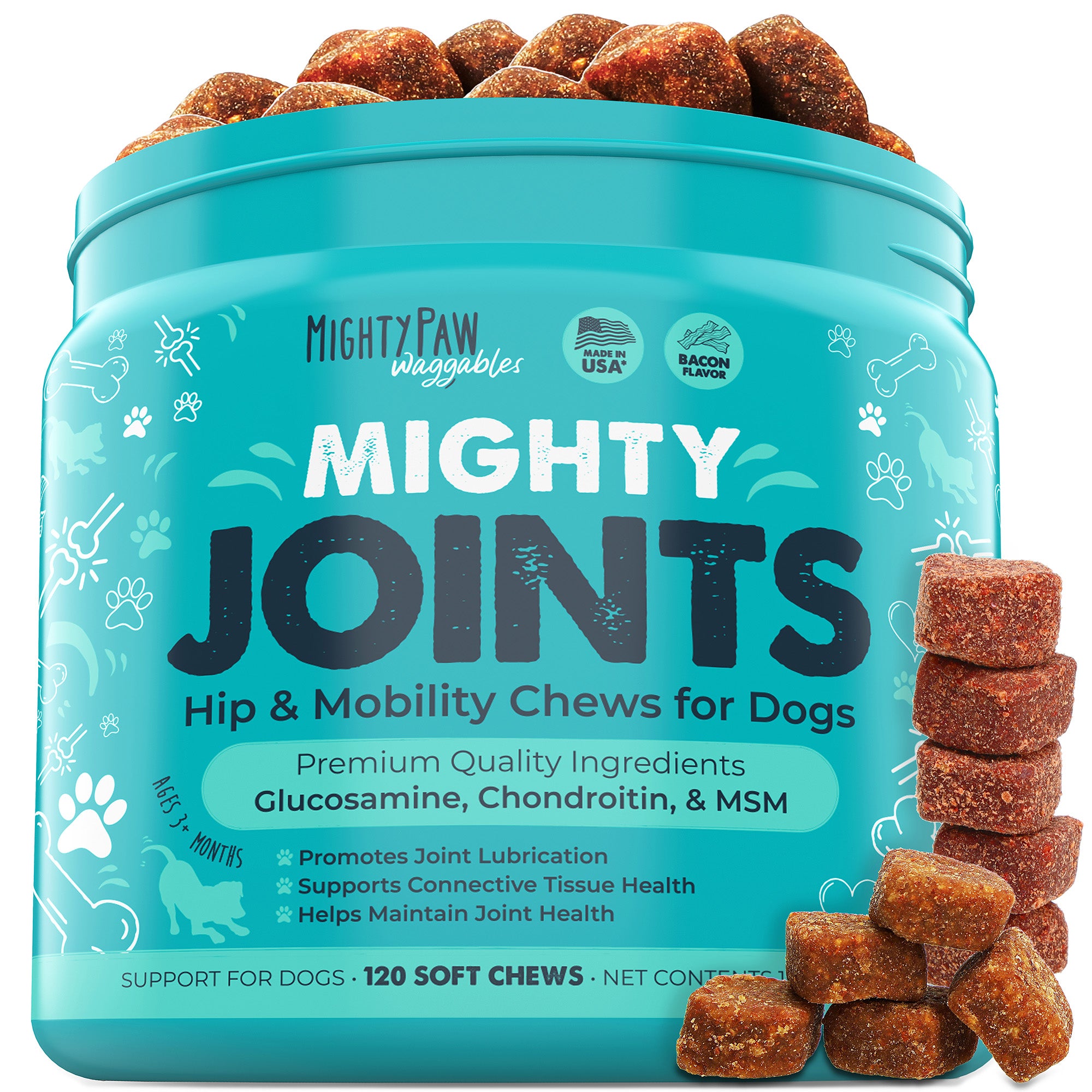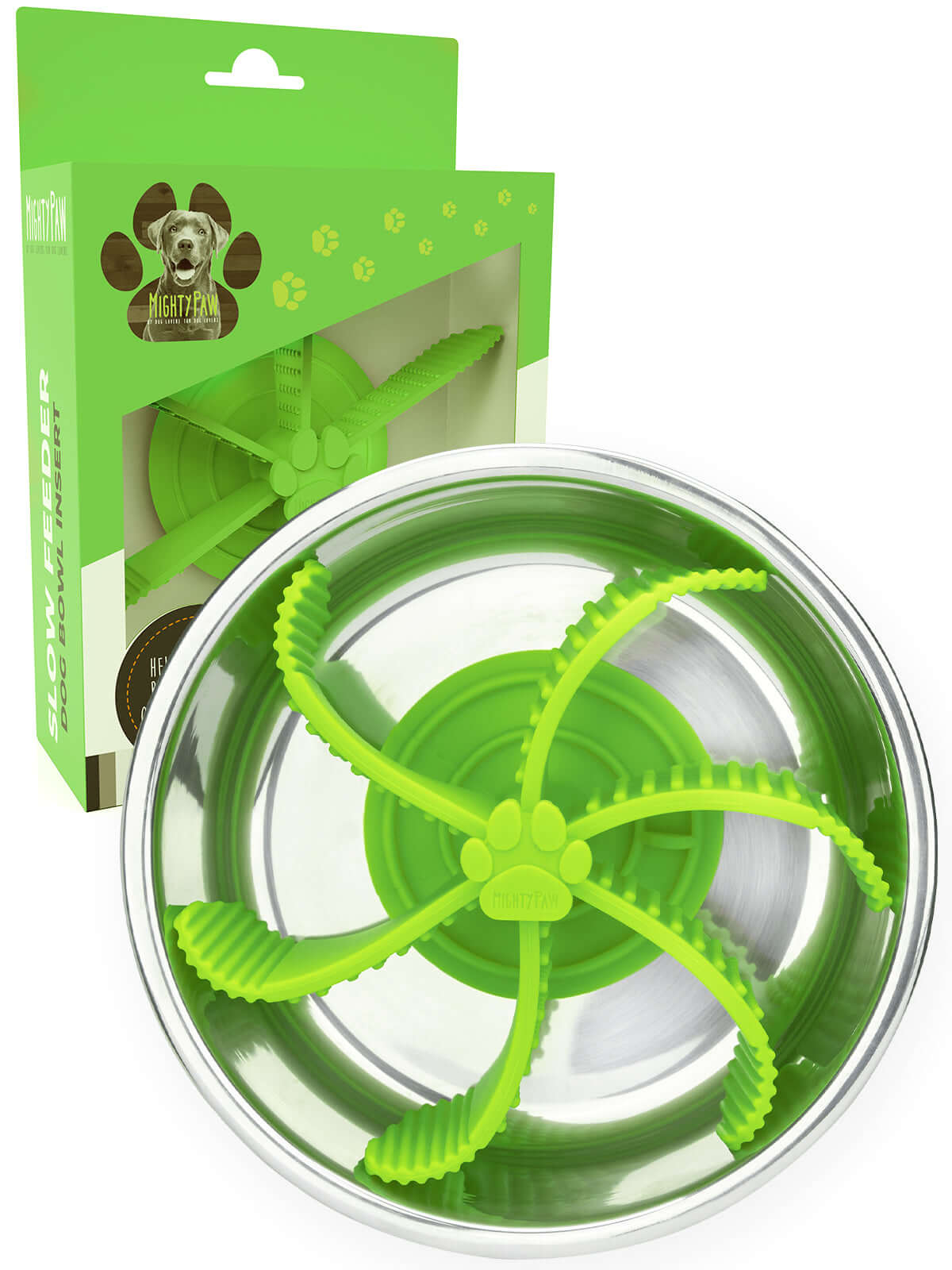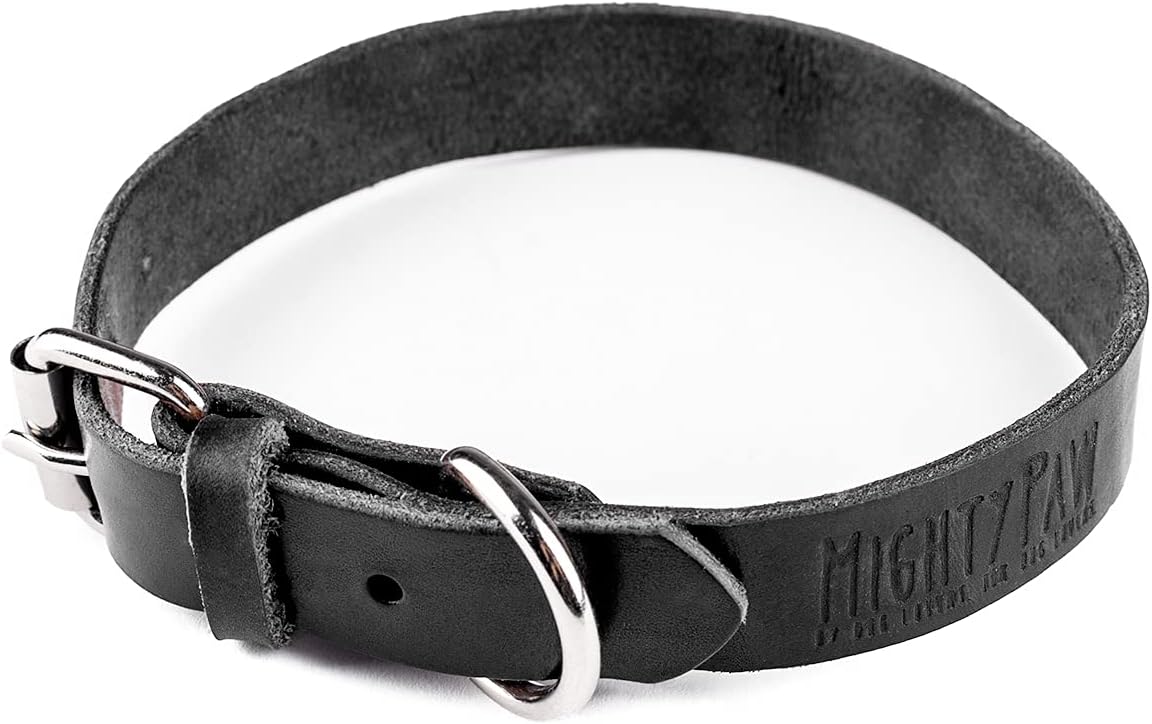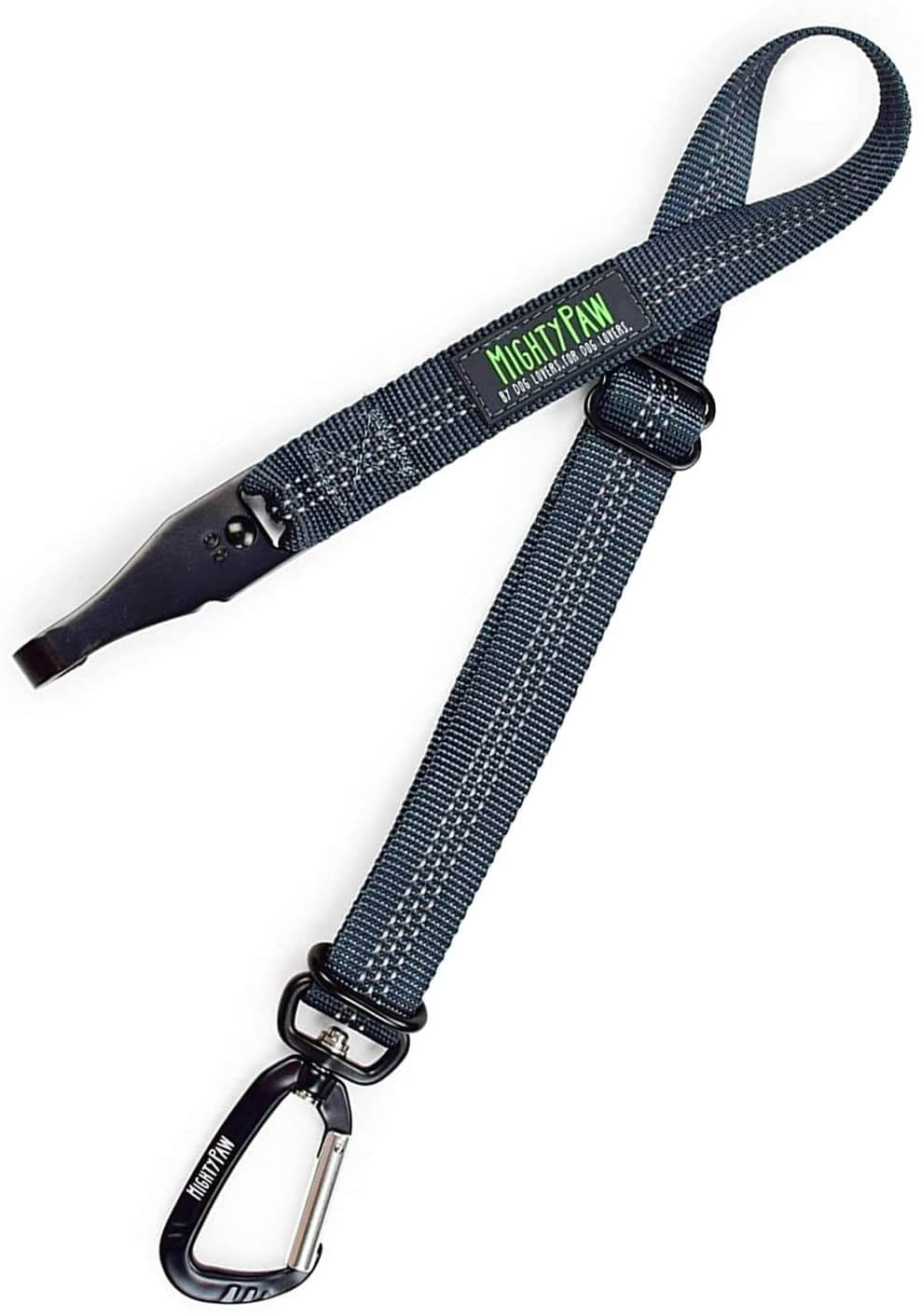If you’re looking for edible dog chews to entertain your dog and stop them from chewing inappropriate things, you’ve come to the right place!
Here at Mighty Paw, we carry several fully digestible dog chews as part of our Naturals line and strongly believe that dogs should be encouraged to chew - except not on things like your furniture, shoes, leashes and walls!
Instead, they need to be offered the appropriate item to chew on.
In other words, edible dog chews!

Now, you may think well that’s easy, I’ll just go to the store and grab some.
Mmh, not so fast! While there are a VAST variety of dog chews, not all of them are created equally, and some are downright dangerous for your pup.
That’s why in this blog post, I’m going to point out the healthy types of edible dog chews as well as those (ingredients) that belong in the trash.
Redirect Your Dog's Destructive Chewing With These Healthy Edible Dog Chews
But first, let’s talk about the why behind all of this chewing business!
Why Is Chewing Good For Dogs and Why Do Dogs Like To Chew On Bones?
When we think of chewing dogs, most of us probably envision a dog who’s chewing on a bone, right? But why do dogs like to chew so much?
Well, chewing is a natural dog behavior that all dogs are born with!
It’s really important to encourage it too because it comes with lots of benefits:
- Helps clean teeth of plaque and tartar
- Strengthens and exercises jaws
- Lessens gum pain in teething puppies and loosens baby teeth
- Relieves boredom and prevents destructive behaviors
- Helps reduce anxiety
- Provides important nutrients like protein, calcium, phosphorus, glucosamine, chondroitin, collagen and fats (yes, dogs need healthy fats in their diet!)
The thing with bones is that they’re not always the most convenient chew to offer our pups because they need to be raw in order to be properly consumed and digested.
Just FYI, as a raw feeder with many years of experience under my belt, I’ve learned that raw bones like duck necks and chicken feet are extremely pliable and soft. At that stage, they’re easily digested because our dogs’ digestive systems are very acidic. They’re essentially made to break down raw bones no problem.
Bones actually don’t risk splintering until they’ve been cooked, which changes their density and turns them brittle. That’s why you should always avoid giving your dogs access to cooked bones.
However, this is not an article about raw feeding for dogs, so I’m going to leave it there as far as actual bones are concerned.
So what are good chewing alternatives for raw bones?
You’re going to find out in this blog post, so keep reading!
One more challenge I wanted to point out first is that it’s important to understand that dogs have different chewing preferences and habits.
Some pups are total power chewers that will destroy any chew within less than 30 minutes.
Others are moderate chewers who happily gnaw away on the same chew for a few days.
Then there are those who aren’t big into chewing and will only chew a few times per week or when they’re looking for anxiety relief.
These different chewing preferences are something to keep in mind when you’re looking for the perfect chew for your pup.
But either way, regardless of which chewing category your pup falls into, we have your needs covered!
That’s because our chews come in different sizes and thicknesses, so there’s something for all types of chewers.
Before we talk about the different types of edible dog chews, let’s cover one more question!
Should I Supervise My Dog’s Chewing Sessions?
Yes, you should!
While chewing is a natural dog behavior, it’s still important to supervise chewing time.
Why?
Because even the most seasoned chewer can potentially choke on a chew or break a tooth!
That’s why we recommend always supervising your pup when they’re chewing, regardless of whether you’re at work for several hours at a time or just out of the house for a quick grocery run.
Now please don’t get us wrong - there’s a really good chance that nothing’s going to happen to your pup when they’re left alone with their chew. But in our opinion, it’s just not worth the small risk of something happening after all.
So when you do leave your pups alone, we recommend exercising them thoroughly beforehand. That’ll get rid of much of their energy and will likely leave them snoozing.
One more thing, dog chews that your dog considers to be of high value are a great tool to help with crate training, but only while you’re at home and supervising.
We do not recommend leaving your dog alone in their crate with an edible dog chew.
The Different Types of Edible Dog Chews: Which Ones Are Safe For Dogs?
OK, now as I already pointed out, there are SO MANY different types of edible dog chews!
If you’ve ever walked down the chews and treats aisle in any pet retail store or scrolled through the virtual aisles online, you know what we’re talking about!
However, in our humble opinion, the best ones that we feel 100% comfortable feeding and treating our pups with on the reg are so-called single-and limited-ingredient dog chews.

As their name suggests, they’re only made of one or a few select ingredients as opposed to a bunch of different chemical and artificial components that are harmful when fed on a regular basis.
These types of chews are a great option for dogs who are on dietary restrictions as well as those who suffer from allergies caused by specific food sensitivities.
Let’s take a look at single-ingredient dog chews first, followed by their limited-ingredient and partially edible counterparts.
Single-Ingredient Dog Chews
These types of dog chews are typically dried or baked and consist of one specific animal part only that lends itself great for doggie chewing purposes.
The positive side effect with these types of chews is that the animal parts they’re made with don’t just get thrown out when the food industry processes the animals for their meat.
Instead, they’re put to some very good use: chewing fun for our best friends!
Bully Sticks
For example, Bully Sticks!
Here at Mighty Paw, all our team pups LOVE bully sticks, and we love handing them out just as much.
After all, they’re the epitome of a single-ingredient, natural dog chew since they literally consist of only one ingredient: dried beef pizzle.
Not sure what pizzle refers to?
It’s a bull penis.
Granted, it may sound gross at first, but trust me when I tell you that dogs go bonkers for these!
The beautiful thing about bully sticks is that they are fully digestible and rich in protein which helps build muscle tissue and grows skin as well as hair cells.
Additionally, bully sticks are particularly suitable for dogs with sensitive stomachs and chicken, lamb, pork, fish and grain allergies.
They come in different lengths and thicknesses, which means they’re not only a great option for all size pups but it also takes different chewing styles and habits into consideration.

Here at Mighty Paw, we carry the following Bully Stick varieties:
- 10 piece Variety Pack
- 5 piece 12" Standard Pack
- 5 piece 12" Thick Pack
- 5 piece 12" Jumbo Pack
- New as of 2022: Our Braided Bully Sticks
You also have the option to purchase our Bully Sticks in bulk.
Pro Tip:
You can shove your pup’s bully stick into a hollow toy to make it last even longer!
Pig Ears & Cow Ears
Pig ears and cow ears are another favorite single-ingredient dog chew snack here in our pack.
They’re pretty much exactly what their name suggests - dried ears from pigs and cows.
Naturally rich in protein, glucosamine and chondroitin as well as low in carbs and cholesterol, they’re a great addition to your pup’s diet for their skin and joint health.
Chondroitin and glucosamine are a building block of cartilage, stimulate the growth of cartilage and help repair damaged cartilage.
Just like our bully sticks, the ears are fully digestible. They’re also a great option for dogs who don’t do well with chicken, lamb and grains.
Pig ears are either sold as one whole ear or in halves.
The ones we carry here at Mighty Paw are half pig ears. That way, they’re a good size chew for dogs of all sizes, just like our bully sticks.
The Mighty Paw Naturals Pig Ears come in a bag of 12 half ears that are 6" long on average, and they're also available as 3, 6 or 9lb bulk orders.
Pro Tip:
Pork is a fattier food than beef, so if your dog is overweight, don’t feed more than 1-2 pig ears per week.
Pig Feet
Another single-ingredient pork chew that’s fully digestible are pig feet aka pig trotters.
They’re rich in protein and a great source of natural fat.
However, since they tend to be a bit more on the caloric side of chews, pig feet shouldn’t make it on your list of chews to offer your pup too regularly.
Once every 10-14 days or so is sufficient, especially if your pup is not a giant breed.

Antlers
Antlers are single-ingredient, hard chews that are naturally shed and then harvested, either from deer or elk.
They’re fully digestible and rich in phosphorus which is great for healthy bones and teeth.
They’re typically available as a whole antler or as a split half antler.
Most dogs thoroughly enjoy the texture and flavor that antlers come with.
Whole antlers are great for power chewers because it takes them longer to get to the tasty marrow part that’s on the inside of the antler.
Likewise, half antlers are a good option for moderate chewers because they can easily access the exposed marrow part of the antler.
Pro Tip:
If your dog doesn’t take to chewing on antlers right away, soak them in bone broth for a while. It’ll likely entice them to start chewing!

Beef Trachea
Similar to pig ears, beef trachea is rich in glucosamine and chondroitin, which makes it a great chew for joint health.
It’s also a single-ingredient chew that’s fully digestible, high in protein and low in fat.
Other than bully sticks, pig feet and antlers, beef trachea is more on the crunchy side and not the best option if you’re looking for a long lasting option for your power chewer.
However, just like the pig ears, it’s safe to freeze beef trachea and then offer it to your pup frozen. Since it’s hollow inside, you can also fill it with your pup’s raw or wet dog food for an even longer lasting chewing session.
Alternatively, you can mix your pup’s kibble with a little peanut butter or pumpkin purée and stuff the beef trachea with that mix.

Chicken & Duck Feet
Chicken and duck feet are also fully digestible and make a great chew for smaller pups. They’re more of a scrumptious treat for larger dogs due to their fairly small size.
Since they’re rich in glucosamine and chondroitin, both are great for joint health.
Pro Tip:
If you suspect or know that your pup doesn’t do well with grains, it’s better to offer duck feet as opposed to chicken feet because chickens are usually fed grains.

Cow Hooves
Cow hooves are another fully digestible, great single-ingredient dog chew, especially for power chewers.
They’re high in protein, low in fat and can be offered on a regular basis.
Our Mighty Paw Naturals Cow Hooves come in a 6 pack.
Pro Tip:
Since cow hooves are typically hollowed out and naturally hard, you can fill them with your pup’s raw or wet dog food and freeze overnight.
If you feed kibble, you can add a little peanut butter to make the concoction stick. It’ll turn into a wonderful dog food puzzle your pup’s going to be busy with for a while!
Lamb/Water Buffalo Horns
Similar in their consistency to cow hooves, lamb and water buffalo horns are also fully digestible and a single-ingredient dog chew.
They’re available either filled with marrow or hollowed out like cow hooves.
You can turn them into a dog food puzzle for your pup when they’re hollow, just like the cow hooves and the beef trachea.
Lamb/water buffalo horns are a great chew option for dogs with food sensitivities to chicken, grains and/or pork.

Sweet Potato Dog Chews
Obviously, sweet potato slices are a vegetable and not an animal part, but their chewy consistency makes them a great dog chew nonetheless.
They’re fully digestible and naturally rich in fiber which promotes healthy digestion.
However, since they’re also rich in carbs and starch, they shouldn’t be offered to dogs who suffer from cancer. That's because cancer cells thrive and multiply on starch.
Pro Tip:
If you have a food dehydrator, you can make your very own sweet potato dog chews.

Limited-Ingredient Dog Chews
These types of dog chews typically consist of 2-5 select ingredients.
Yak Cheese Dog Chews
These particular chews are sourced in Nepal, in the Himalayas. They're another favorite with our pups because they’re magical...sort of!
Why is that?
Because you can easily turn any leftover pieces into a brand new treat that we like to call crunchy cheese puffs. But more on that later.
Let’s start with their ingredient count first.
The Mighty Paw Naturals Yak Cheese Dog Chews consist of only 3 ingredients:
- Yak & cow milk
- Lime juice
- Salt
That makes these Dog Chews fully digestible, lactose-free, grain-free, gluten-free, chemical-free, preservative-free, and most importantly: guilt-free!
...and just in case you’re wondering: The curing process removes the lactose from the milk, so they’re a great chew for pups with sensitive stomachs, too.
The lime juice and the salt act as natural preservatives and are only present in really small quantities.
Yak Cheese Dog Chews are pretty hard, which makes them a great long-lasting chew alternative to bleached rawhides.
How to turn a leftover Yak Cheese Dog Chew into a crunchy cheese puff treat
When the end piece reaches a size that can easily be swallowed whole, we suggest turning it into a crunchy cheese puff treat instead.
That way, you don’t have to waste any of it!
All you need for this is an end piece, a bowl with water and a microwave.
Soak the end piece in the bowl with water for about 5 minutes, then place the soaked chew onto a microwavable dish and microwave it for 45-60 seconds.
It’ll puff up to about 3 times the size of the original end piece and will have a super crunchy texture.
Let it cool off for a few minutes until it’s no longer hot to the touch, then offer it to your pup.
If they’re watching you make these, there’s a good chance they’ll start drooling in anticipation, so be prepared for that!
Pro Tip:
If your microwave is a bit on the older side and not as powerful as new microwaves, it won’t puff up as much. In that case, you can try microwaving it for a bit longer, around 2 minutes or so.
One more tip:
Since the texture is really crunchy, you may want to offer the cheese puff on a surface that’s easy to clean because there will be crumbs!
Partially Edible Dog Chews
Besides single-and limited-ingredient dog chews, there are also a few partially edible ones, but in my humble opinion, only one kind makes the healthy, safe cut, and that’s marrow bones.
Marrow Bone Dog Chews
As the name suggests, these are bones that are filled with natural bone marrow.
Most dogs really like these, and ours are no exception!
They can provide hours of entertainment for your pup, but you want to pay close attention to your pup’s chewing sessions. That’s because the bone itself is really hard and has the potential to crack a dog tooth.

Once your pup has eaten all of the marrow, it depends on their chewing habits as to what you might want to do with the bone.
If they’re a really aggressive power chewer who’ll want to continue chewing/eating that bone, it’s safer to toss it.
However, if they’re a moderate or light chewer who’s not overly interested in the bone itself, you can keep it and fill it with something other than marrow.
For example, peanut butter, pumpkin purée, wet dog food, raw dog food … whatever your pup likes!
Good to know:
These types of chew bones are somewhat smelly and more on the messy/greasy side of things. Since they can leave stains, our suggestion is not to offer them on furniture, bedding, carpet or rugs. Instead, it’s much more pleasant to feed them outside, on a tile floor or in your pup’s crate - and remember to supervise, please!
Dog Chew Ingredients & Dog Chews To Avoid
There are so many harmful ingredients that are completely superfluous yet still make it into dog chews and treats, it’s maddening and sad all at once!
Listed below, you’ll find the main ones to look out for and avoid.
Pro Tip:
They’re typically found in dog chews with long ingredient lists:
- Anything that mentions flavor. Bacon flavor, peanut butter flavor, cheese flavor, beef flavor, smoke & natural flavor, etc.
- Grains. (Buck)Wheat, Barley, Rye, Millet, Sorghum, Corn, Rice etc.
- Artificial colors & preservatives. Caramel Coloring, Ethoxyquin, Yellow 5 & 6, Red 40, Blue 2.
- Synthetic components. Propylene Glycol, Corn Syrup, Carrageenan, Xylitol, Sodium Nitrate, Sodium Hexametaphosphate, Sodium Tripolyphosphate, Taurine, Potassium Sorbate.
- Empty fillers. Cellulose, pea protein, corn.
- Rendered animal fat and canola oil.
- Bleached rawhide dog chews & stuffed shin bones.
- Weight-carrying bones from large animals.
Anything that mentions flavor: Flavor translates into something that’s not natural that has to be added in artificially.
Chews with grains: They can trigger allergies that cause itching and hot spots in dogs with food sensitivities. That’s why it’s best to avoid them altogether.
Highly processed treats and chews with a variety of unpronounceable ingredients on the ingredient list: Skip ‘em! Chemicals and artificial ingredients and colors are harmful when your dog is exposed to and eats them on a regular basis. Many of them are known carcinogens while others can cause intestinal inflammation, skin allergies and neurological disorders.
Also, dogs really don’t care what color their chews are, so there’s that!
Empty fillers. These are added to artificially bulk up the protein level in dog chews (and food too) although they don’t have any nutritional benefits for dogs.
Rendered animal fat. This translates into rancid and moldy fat from all sorts of dead animals, regardless of whether they were roadkill or euthanized.
Canola oil. It's a vegetable oil that’s very rich in Omega-6 fatty acids. When your pup consumes more Omega-6 fatty acids than Omega-3 fatty acids, they experience inflammation within the body that causes itching and scratching.
Bleached rawhide dog chews: These are loaded with artificial nonsense, including glue!, that cause poor digestibility as well as internal blockages when larger chunks of it are swallowed.
They’re a highly controversial dog chew that we personally don’t offer our own pups.
If you really want to be appalled, do an online search for how rawhide dog chews are made.
Spoiler alert: It's really upsetting.

Stuffed shin bones: They’re filled with several unhealthy ingredients such as artificial peanut butter/cheese/bacon flavor, vegetable glycerin, beef meal and potassium sorbate. Additionally, they also fall into the category below.
Weight-carrying bones from large animals: You definitely want to avoid those types of bones because they’re a lot more dense, i.e. hard, than those from other body parts.
A really good example are those smoked, huge beef bones you can find at most grocery stores. I learned the hard way that those are a no-go when one of my pups broke an upper molar on one. Now his tooth is gone and my vet is $600 richer.
Pro Tip:
When edible chews become too small so that they can easily be swallowed, remove them and throw them out.
As I pointed out earlier, Yak Cheese Dog Chews are one exception to this because the small end piece can be microwaved and turned into a delicious, crunchy cheese puff!
We’re sharing a detailed how-to blog post with video instructions at the end of this blog post, so be sure to check it out!
How To Introduce Your Dog To New Edible Dog Chews
You should introduce your dog to any new chews gradually over the course of several days.
How long exactly depends on how sensitive your dog’s stomach is, so it’s important to know your pup.
As a general rule of thumb, you should remove the new chew after 5-10 minutes if it’s made with ingredients your dog isn’t familiar with yet.
Remember that your dog’s stomach needs 7-10 days to adjust to new snacks just as he or she does when you’re switching between different dog food (brands).
Pro Tip:
Hold your dog’s chew on one end while you let your pup sniff it and take their first few licks. This teaches your dog polite behavior around food items that humans hold in their hands. It also makes it easier to remove a new chew after a few minutes!
Some dogs also need a bit longer to warm up to new edible chews they haven’t had yet.
That’s particularly true for smaller breeds who are known to be more finicky with snacks and food in general!
For those pups, try dipping the chew into some warm bone broth or smear some peanut butter on it.
Sometimes they just need a little incentive to get going.
Once they start chewing and their saliva softens the chew a bit, they’re likely to be more enthusiastic about a new edible chew.
Which brings us to one last question!
How Long Should Dog Chews Last?
Fureverrrr!
Well, that would be awesome but all jokes aside, ideally as long as it takes to tire your pup out a little.
Obviously power chewers are going to need less time to chew than moderate chewers.
That’s why it’s important to know your individual dog’s chewing style when you’re choosing and assessing the cost per usage ratio for an edible dog chew.
Generally speaking, Antlers, Bully Sticks, Yak Cheese Dog Chews, Cow Hooves and Lamb Horns are going to last longer than Pig Ears, Duck Feet and Beef Trachea.
But again, it depends on your individual dog and their level of chewing.
If you’re looking for a long-lasting chew for your new dog, you may have to invest in a few different ones to find out what kind of chewer he or she is!
Redirect Your Dog's Destructive Chewing With These Healthy Edible Dog Chews: The Rundown
So there you have it!
Now that you know that chewing is an innate behavior that should be encouraged because of its many benefits, go ahead and order some edible dog chews to keep your pup entertained.
Your furniture, shoes and leashes will thank you!
However, please remember to consider what they’re made of before you purchase any dog chews. So many consist of questionable ingredients that are artificial and downright harmful when fed regularly. One of the worst ones are certainly bleached rawhide dog chews.
That’s why we can’t stress the importance of reading ingredient labels enough!
That said, the best edible dog chews are single- and limited-ingredient ones that consist of only one or a few select ingredients that you can pronounce without twisting your tongue.
Our favorite all-natural dog chews are Bully Sticks, Yak Cheese Dog Chews and Pig Ears, which is why we decided to carry them in the first place!
We also want to point out that while chewing has lots of benefits and is a wonderful way to mentally engage your pup for a while, it doesn’t replace daily walks and playtime.
Ideally, all three activities should be a part of your dog’s daily routine to help them thrive, stay healthy and keep them at their happiest!
Ready to offer your pup some mighty chewing fun? Then head over to Mighty Paw and explore our chew variety:
Mighty Paw Naturals Dog Chews & Treats
If you enjoyed this blog post, you may also like:
- Introducing the Mighty Paw Yak Cheese Dog Chews
- DIY Dog Treats: How to Turn A Leftover Yak Cheese Dog Chew into a Crunchy Cheese Puff
- Discover Mighty Paw's New Fully Digestible Pig Ears For Dogs
- Reward Your Pup With Mighty Paw's All-Natural Bully Sticks
- 4 Single Ingredient Rawhide Alternatives for Dogs









